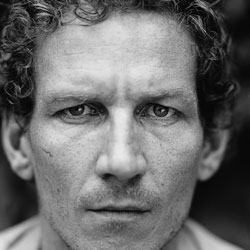Cargo has let down
her hair a little and stopped pushing
Pliny the Elder on
the volunteer labour
During summer it was all Pliny the Elder,
Pliny the Elder, Pliny
the – she’d cease only
for scotch thistle, stale Cheerios, or to reflect
flitty cabbage moths
back at themselves
from the wet river-stone of her good eye. Odin,
as you already know,
was birthed under
the yew tree back in May, and has made
friends with a crow
who perches between
his trumpet-lily ears like bad language he’s not
meant to hear. His mother
Anu, the jennet with
soft hooves of Killaloe, is healthy and never
far from Loki or Odin.
The perimeter fence,
the ID chips like functional cysts slipped
under the skin, the trompe
l’oeil plough and furrowed
field, the UNHCR feed bag and visiting
hours. These things done
for stateless donkeys,
mules, and hinnies – done in love, in lieu of claims
to purpose or rights –
are done with your
generous help. In your names. Enjoy the photo.
Have a safe winter
outside the enclosure
Notes on the Poem
This weekend, we're thankful for many things ... including the wealth of poetry we have here to enjoy and relish. Let's reprise and savour again one of our favourites. What inspires an artist to create has always been a source of speculation and wonderment for those not so gifted or inclined, but grateful for those fruits of artistic inspiration. You name it, and someone has probably painted a picture, penned a song, crafted a poem, or birthed some work of incredible art sparked by clear, sometimes surprising, sometimes unlikely and sometimes obscure sources of inspiration. Ken Babstock's "Autumn News from the Donkey Sanctuary" boasts an unusual poetic muse that is one of the poem's singular delights. Babstock shares in an interview how he learned about the donkey sanctuary and its newsletter. Descriptions and names from the newsletter are the starting point for Babstock to progress through the possible characters of and interactions among the scarred, "stateless" but gentle and gently healing donkeys, to a suggestion that how they are subsisting, surviving and thriving offers lessons for us all. Babstock's poem presciently complements a brief reflection on the donkey sanctuary web site about anthromorphism. Attributing human characteristics, reactions or behaviour to non-human entities, including animals, is inaccurate, potentially troublesome, maybe presumptuous ... but also tempting, comforting and even instructive at times, as both the donkey sanctuary correspondent and Babstock suggest. We don't know for certain if Cargo has really "let down / her hair a little", but if she seems more relaxed and not going on about whatever (Pliny the Elder as likely as anything), we could all stand to follow her example, stop and enjoy our stale Cheerios too. We also don't know if Odin and the crow are friends or the crow is tormenting him, but we can all learn and benefit from relationships outside our immediate circles. Inspiration doesn't have to be lofty or conventionally beautiful to potently inform an artistic creation. What are the most unusual sources you've seen most skillfully and memorably woven into poetic form?
